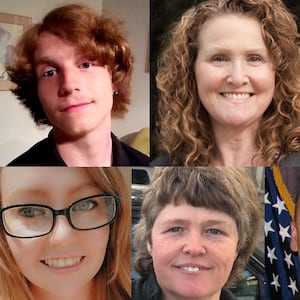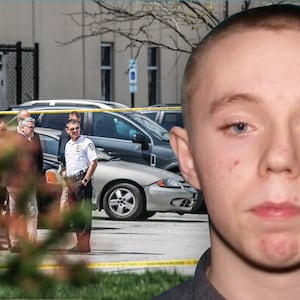Dr. Comilla Sasson spent the weekend at her Colorado home awaiting the results of a COVID-19 test her 6-year-old was given after developing a fever.
On Monday morning, the 42-year-old emergency medicine physician got word that the results were negative. She herself is fully vaccinated, along with 26 percent of the adults in her state. Her husband is one of the 43 percent who have received at least one shot. And even though her state is among the 22 with increased new cases, the numbers are considerably lower than they were at their height. She dares hope the whole country is emerging from a pandemic whose first horrific surge she witnessed as a volunteer in New York City a year ago.
“Finally, there’s a light at the end of the tunnel,” she told The Daily Beast. “It’s getting better.”
But even if the virus were completely quelled, Sasson would not be ready to say we are back to normal. She does not think we were there to begin with.
Two other public health threats—gun violence and drug overdoses—have gotten only worse during the pandemic, both spiking to all time record levels. Sasson has taken particular notice of the shootings that come into the ER one after another after another.
Back in 2012, Sasson was one of only two doctors on duty when her emergency room received 23 of the 70 victims of a gunman who opened fire with an assault rifle at a midnight showing of a Batman movie in Aurora. Gun killings in America have since climbed from a total of 11,626 that year to an all-time record of 19,380 in 2020.
“As one pandemic ends…” Sasson began to say.
She then caught herself, because a pandemic is global. The gun carnage in America is unlike that in most of the rest of the world.
“It’s not even a pandemic,” she said. “It’s a U.S.-based epidemic. We have a terrible epidemic of gun violence in this country and we haven’t done anything to make it better.”
And for an ER doctor, that too often translates into losing patients to bullets despite all your knowledge and skill and determination.
“I don’t want to tell another family that they lost their child or brother or sister,” she said.
She added, “We’ve seen enough of this to know none of this is normal. It doesn’t have to be how it is.”
Only with last month’s spa shootings in Atlanta, followed by a grocery store massacre in Boulder, did the threat of firearms cease to be eclipsed in the public consciousness by the danger of the coronavirus. Sasson took particular notice of the news footage showing ambulances just standing at the scene of the mass shooting in Boulder. She understood that meant there was no reason to rush to the hospital because multiple people inside the supermarket had been declared dead. The toll came to 10, including a police officer who left seven children.
Then, on Friday, Sasson learned of yet another mass shooting. A 19-year-old armed with two assault rifles had killed eight at a FedEx facility in Indianapolis.
“You can’t even keep up there are so many of them,” Sasson said.
She was reminded that assault weapons are aptly named.
“It’s amazing to me the amount of destruction you can do with an assault rifle in 10 minutes or less,” she said. “They really are weapons of mass destruction. You don’t even need any kind of aim. You just shoot.”
News stories said the gunman had come to the attention of the police last year after his mother called to report he was suicidal. Police had confiscated a shotgun and taken him to a hospital, where he was placed on a psychiatric hold.
“They thought he was dangerous enough to take away his gun,” Sasson noted.
She said she has often taken care of people who arrive in the ER with mental health issues, which are much trickier to treat than a broken bone.
“I don’t know what happens to them after the psychiatric hold goes away,” she said. “Many of them go through the system again and again.”
But if part of the problem is a shortage of psychiatric hospital beds, the critical factor is too many easily accessible firearms. The FedEx shooter was known to be a danger to himself. He became a danger to others when he had a gun in his hands.
The same principle applies to the thousands of shootings that go unnoticed except by those who are directly affected by them. That includes the dozens of children who die in shooting accidents each year.
“It is all 100 percent preventable,” Sasson said.
She emphasized that she speaks about reducing gun violence as a doctor, just as she has about mitigating COVID-19.
“In this country, guns, vaccine, everything has been politicized,” she said. “At the end of the day, I’m not being political. I’m just telling you what I know about how to save lives.”
She allowed that we are still many vaccinations away from defeating the virus. But we are well on the way. And we have shown we are able to summon all our reserves to address a public health emergency.
“If we can do it with COVID, I feel like we should be able to do the same with gun violence,” Sasson said. “We have the resources. We have the data. We just have to do it.”
She believes we also possess the element that proved most essential in battling the virus.
“We have the will,” she said. “I think that’s the big thing.”
If that is so, then we might someday arrive at normal as understood by countries where there are not more guns than people.
Meanwhile, Sasson and her fellow ER doctors will keep giving their all for whoever is brought into the country’s emergency rooms. She will even treat those who start out shooting and end up getting shot.
“I’ve taken care of many shooters before,” she said. “Sometimes right next to the person they shot. Sometimes you don’t know who the shooter is. You just treat them.”




